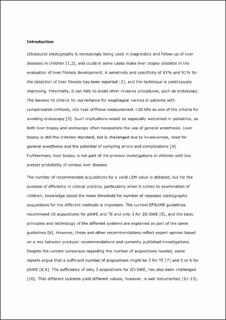Liver elastography in healthy children using three different systems - how many measurements are necessary?
Mjelle, Anders Batman; Mulabecirovic, Anesa; Havre, Roald Flesland; Olafsdottir, Edda Jonina; Gilja, Odd Helge; Vesterhus, Mette
Journal article, Peer reviewed
Accepted version

Åpne
Permanent lenke
https://hdl.handle.net/11250/2732704Utgivelsesdato
2020-12-21Metadata
Vis full innførselSamlinger
- Department of Clinical Medicine [2066]
- Registrations from Cristin [9791]
Sammendrag
Purpose Liver elastography is increasingly being applied in screening for and follow-up of pediatric liver disease, and has been shown to correlate well with fibrosis staging through liver biopsy. Because time is of the essence when examining children, we wanted to evaluate if a reliable result can be achieved with fewer acquisitions.
Materials and Methods 243 healthy children aged 4–17 years were examined after three hours of fasting. Participants were divided into four age groups: 4–7 years; 8–11 years; 12–14 years and 15–17 years. Both two-dimensional shear wave elastography (2D-SWE; GE Logiq E9) and point shear wave elastography (pSWE; Samsung RS80A with Prestige) were performed in all participants, while transient elastography (TE, Fibroscan) was performed in a subset of 87 children aged 8–17 years. Median liver stiffness measurement (LSM) values of 3, 4, 5, 6, 7, and 8 acquisitions were compared with the median value of 10 acquisitions (reference standard). Comparison was performed for all participants together as well as within every specific age group. We investigated both the intraclass correlation coefficient (ICC) with absolute agreement and all outliers more than 10 %, 20 % or ≥ 0.5 or 1.0 kPa from the median of 10 acquisitions.
Results For all three systems there was no significant difference between three and ten acquisitions, with ICCs ≥ 0.97. All systems needed 4 acquisitions to achieve no LSM deviating ≥ 1.0 kPa of a median of ten. To achieve no LSM deviating ≥ 20 % of a median of ten acquisitions, pSWE and TE needed 4 acquisitions, while 2D-SWE required 6 acquisitions.
Conclusion Our results contradict recommendations of 10 acquisitions for pSWE and TE and only 3 for 2D-SWE.